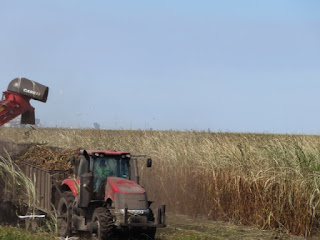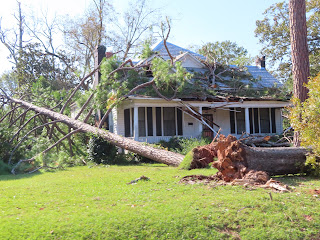We came upon a bear crossing sign. However, this bear
crossing sign looks like a polar bear, not a black bear. I doubt there are
polar bears crossing US 27 south of Lake Placid, but we did not see any black
bears in the next 12 miles either!
I know that the citrus greening disease,
Huanglongbing, has had a fatal effect on the citrus groves in Florida. The
disease is spread by a pest called the Asian citrus psyllid as it feeds on
citrus tree leaves and there is no cure. It is nice to pass by orange groves
that are being rebuilt by the growers.
We passed Gatorama, it was the first sign of life in
miles. What is Gatorama? It was started in 1957 by an old colorful character
named Cecil Clemons. When Gatorama began, US 27 was a two lane road. Cecil
believed that when most Yankee’s came to Florida they wanted to see three
things: the beach, an orange grove and an alligator. He was going to show them
alligators! Cecil was quite the character and Gatorama used to have quite a
different reputation than it does now.
Since 1987 they have worked very hard to build a
reputation as an upright hard working law abiding farm and family attraction.
Gatorama is one of 12 remaining of the original 72 attractions operating in the
heyday of roadside tourist attractions in the 50s and 60s before the big mouse
moved to Florida. This part of Glades County use to be referred to as Red Bug
Ridge, it was a high sandy ridge running through the glades. Alligators were
naturally found in this area. Cecil bought the land and fenced the alligators
in. The large alligators in the front pond are some of the original stock and
the biggest are well over 60 or 70 years old.
The crocodiles were brought into Gatorama in 1968
before they were an endangered species. Crocs natural range is from about
Sanibel Island south. They are now mostly found in the Florida Keys. Gatorama
has the only productive breeding colony of American Crocs in the US and we are
one of the few facilities permitted to accept nuisance crocs from the wild.
Nuisance crocs must be relocated….they cannot be harvested the same as nuisance
alligators are.
David Thielen, was raised in Lakeport and for a time
lived near Cecil. After a career as an army officer he retired and wanted to
come back to his childhood home. His wife, Marietta, a Yankee, did not, but she
soon relented. At about the same time it became legal to farm alligators in the
state of Florida. Gatorama are pioneers in the alligator industry. They hold
two of the original 30 permits. David’s interest was in developing the
alligator farm, though he intended to keep his promise to Cecil and keep the
attraction open and not sell off the valuable alligator and crocodile stock. By
2007 those original golden thirty permits have been consolidated and are now
held by about 10 families’ who farm alligators commercially.
Moore Haven Lock & Dam Recreation Area is a US
Army Corps of Engineers area, located on the west side of Lake Okeechobee at
the junction with the Caloosahatchee River. The Corps constructed and currently
manages five locks along the 152-mile Okeechobee Waterway. Moore Haven Lock and
Dam were constructed in 1935 for navigation and flood control purposes. Today
it also serves as a recreational gateway to the second largest fresh water lake
in the Continental United States, as well as one of the most bountiful fishing
sites for sports fishing tournaments. Approximately 9,200 vessels lock through
annually; of these about 95% are recreational vessels.
We crossed over the Caloosahatchee River. It is
approximately 67 miles long. It drains rural areas on the northern edge of the
Everglades, east of Fort Myers. An important link in the Okeechobee Waterway, a
manmade inland waterway system of southern Florida, the river forms a tidal
estuary along most of its course and has recently become the subject of efforts
to restore and preserve the Everglades.
Clewiston is the town beside Lake Okeechobee. It was
once used as a fishing camp by the Seminole Indians. The first permanent
settlement began in 1920, when John O'Brien of Philadelphia and Alonzo Clewis
of Tampa purchased a large tract of land to establish a town. Incorporated as a
city in 1925, Clewiston would become noted for its sport fishing, particularly
of largemouth bass. Large sugar plantations were established around Lake
Okeechobee. By the 1950s and 1960s, the cultivation of citrus, vegetables and
cattle were also important to the economy. US Sugar Corporation, however,
remained the dominant manufacturer in Clewiston, which became known as
"America's Sweetest Town."
Driving in this part of Florida, we can see tons of sugarcane
fields. Sugarcane is a grass grown primarily for its sugar (sucrose) content.
This field crop has been grown commercially in southern Florida since the 1920s
and is one of the most economically important crops in the state. Approximately
450,000 acres are grown annually, mostly around the lower half of Lake
Okeechobee.
Ever wonder why they burn the sugarcane? I always
assumed it was burned after the harvest, to kill all the roots. No, it is
burned before harvesting to remove the outer leaves around the stalks.
Another first on this Two Lane Adventure …
we got to see some sugarcane being harvested!
 When they have to truck the sugarcane, they can only haul an 18-wheeler at a time across the highway.
When they have to truck the sugarcane, they can only haul an 18-wheeler at a time across the highway.
The Everglades Agricultural Area is along US 27.
Before 1950 the “Central and South Florida Project for Flood Control and Other
Purposes” designated a large area of the northern Everglades as the Everglades
Agricultural Area. Completed in 1962, the project included 15 canals and 25
water control structures managed by the South Florida Water Management District
to serve the EAA. The canals and structures were used to artificially control
water depth in the historic sheet flow area, diverting water from Lake
Okeechobee for farm irrigation. Today, the EAA spans 700,000 acres and
encompasses 27% of the Everglades where sugarcane is the major crop. Nutrient
runoff from the EAA, the result of fertilizers and the use of herbicides and
pesticides, as well as the intensive use of water for sugar and other crops,
are critical problems for south Florida. Restoring the EAA to its historic
function of storage and treatment of water may be a key to the restoration of
the Everglades.
To protect and restore these ecosystems, the South
Florida Water Management District (SFWMD) is working to remove excess nutrients
and other pollutants, or prevent them from entering natural systems. One of
these efforts is building Stormwater Treatment Areas (constructed wetlands.)
This solution for improving water quality is a required element of
federal/state legislation for restoring the Greater Everglades (which includes
the Kissimmee, Okeechobee and Everglades watersheds). It is also mandated by
separate state legislation for water quality improvements in Lake Okeechobee
and the Caloosahatchee and St. Lucie estuaries, as well as in the Everglades
systems south of Okeechobee. SFWMD is creating more than 6,500 acres of new
stormwater treatment areas and 116,000 acre-feet of additional water storage
through construction of flow equalization basins (FEBs). These impoundments
capture runoff during storm events and provide a more steady flow of water to
the STAs, helping to maintain desired water levels needed to achieve optimal
performance. We witnessed this construction along US 27. We could not figure
out what it was for a while. The construction created a ton of dust; it is a
good thing that this area is void of residential areas.
In the heart of South Florida, two major roads, East-West SR
80 and North-South US 27 intersect. At this crossroads, near the southern bank
of Lake Okeechobee, is the City of South Bay. Rich black soil and the lakes
vast waters make South Bay a haven for agriculture and recreation. The
settlement began at the North New River Canal, completed in 1912. Only
12 families lived at South Bay in 1917. During the 1920s, the town filled out
along with Pahokee and Belle Glade to the north.
As smaller settlements
disappeared, these three became known as the Glades Communities. South Bay was
incorporated in 1941. During the 1980s, South Bay was the third fastest growing
major metropolitan area in the nation. Yesterday, it was a hot pink house ... today South Bay boasted a purple business. I loved the color!
We turned off US 27 and onto FL 997, aka Krome Ave. This is a 4 lane highway for a bit, but quickly becomes a two lane road with no passing. There are plastic cones in the center lines to discourage attempting to pass. They even have a couple of signs dedicated to sharing the number of deaths on this road.
We turned onto US 1 in Homestead and quickly arrived at Boardwalk RV Resort, our home for
the night. It was a bit tight to get into our site, but it was clean, pretty well maintained and the staff was helpful and friendly. It's a Passport America Park, so for $25 a night, I am not complaining!






































































